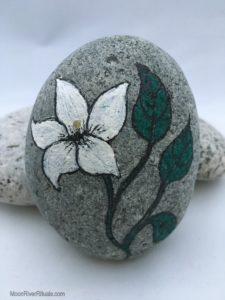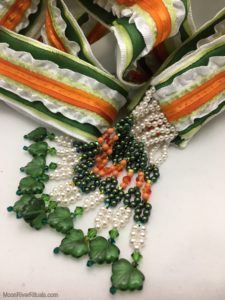
Did you fall in love in Paris? Or Podunk? How can a big city or a small town inspire a wedding ritual? What else can you do with this gifting ritual?
The ancient city of Rome was built on seven hills. One of my couples, Thomas and Raffaele, shared their first kiss in a famous garden on one of those hills. I drew on the magic of that moment and that place to create their wedding ceremony and a particular wedding ritual. Let me give you some context.
In November of 2017, Raffaele and Thomas got married at the elegant and historic Wadsworth Atheneum in Hartford, Connecticut. I was their officiant.
 When I work with a couple, I look for little details that will help me shape their love story and create a unique ritual for their ceremony.
When I work with a couple, I look for little details that will help me shape their love story and create a unique ritual for their ceremony.
This love story started when Raffaele, who lived in Connecticut, had to go to Rome on business. He mentioned the upcoming trip to a group on Facebook and asked if anyone knew someone in Rome who would be willing to show him the sights for the few days he’d be there. Thomas responded. He lived in Rome and would be happy to give Raffaele a tour.
Though Raffaele’s family was from Italy, he, himself, had never been there before. Now, he got to see the legendary Seven Hills through Thomas’s eyes. In doing so, each man realized they shared interests, values, and visions of the future. And, though neither ever expected it to happen, they also shared another kind of attraction.
It was on the third day that Thomas said he wanted to share his favorite place, a truly magical garden. Where some of Rome’s seven hills had gained fame for being home to the richest, or the most powerful, or the biggest, or the one with the strongest fortress, the Aventine was home to the ancient Garden of Oranges. It did prove to be a magical place for it was in that garden that the two men shared their first kiss.
All too soon, it was time for Raffaele to fly back to the States. Learning how to navigate a long-distance relationship was next for the couple. It wasn’t easy but they managed. Love is a great motivator.
On one particular trip, Thomas came to Connecticut to help Raffaele with his business and to meet his family. It was on that trip that they bought wedding rings. For someday.
It would be over a year before “someday” arrived. When it did, both men knew it was time. They set a date, November 12, three weeks away. Yes, three weeks! Fortunately, the Connecticut wedding season winds down at the end of October. So, the men didn’t have the usual challenges of finding a first class venue, photographer, and other professionals they wanted.
In designing their ceremony, I wanted to highlight the Garden of Oranges. Not only was it the place where they shared their first kiss, it was also the name of a new perfume. You see Raffaele Ruberto is the internationally known “beauty biologist,” famed for his highly successful line of skincare products. The perfume was his latest creation. At the rehearsal, I learned that the guests would all receive a bottle of the perfume — Giardino degli Aranci — in a special box commemorating the wedding.
Drawing on the ancient magic of the garden, I wove three rituals into the ceremony.
The Oathing Stone

When Thomas and Raffaelle made their vows, they did so on an oathing stone hand-painted with orange blossoms by my friend and artist, Carol Chaput. First, Thomas held the pale gray riverstone, about the size of a large egg, in his opened palm. Raffaele placed his right hand on top of the stone and made his vows. Then Raffaele held the stone for Thomas.
The concept of oathing stones goes back centuries. We hear it when people make a statement and say, “I swear on my mother’s grave.” In the ancient world, it was an accepted truth that the spirits of those who had died were now in the Underworld and from that realm the dead the ancestors would guide and protect the living.
That connection between the worlds was sacred. In cultures that buried their dead, people would lovingly tend the graves of their ancestors. They would go to the grave to pray. They would leave flowers. They might leave a stone, or plant a tree. They might have a picnic. They might fence off a particularly nice section of land so that all their ancestors would be together. If all that sounds like something we do today, you’re right.
The Underworld was, literally, under the ground. People believed that a stone or piece of a tree that came from the ground where the person was buried held an energetic connection to the dead. If you made a vow while holding that stone or piece of wood, then broke that vow, you would no longer have the protection of your ancestors. You put your life at risk. Literally.
Turn back time and imagine living in a village. Everyone knows everyone else. One of your neighbors commits a crime. When he is accused, he swears on the graves of his ancestors that he didn’t do the deed. Eventually, the truth is revealed and everyone knows the neighbor lied. Far worse than lying, he broke a vow to his ancestors. For that, punishment could mean death. More often, it meant being banished from the village. How could he ever be trusted?
That gravitas is inherent in an oathing stone. Of course, today most people don’t live in small villages. Many don’t even live in the area where they were born. So getting a stone or piece of wood from a tree on the land of their ancestors isn’t feasible. I offer hand-painted stones on my Etsy shop. Of course, you can use any stone, as long as it has meaning to you.
Handfasting
 For Raffaele and Thomas, I followed the vows with a meaningful, and a bit humorous, handfasting. I made their cord in green, orange, and white to echo the colors of the Garden of Oranges. I made it nine feet long because 3×3 is the formula for magic. Plus, with a long cord, they can add a knot as part of each anniversary.
For Raffaele and Thomas, I followed the vows with a meaningful, and a bit humorous, handfasting. I made their cord in green, orange, and white to echo the colors of the Garden of Oranges. I made it nine feet long because 3×3 is the formula for magic. Plus, with a long cord, they can add a knot as part of each anniversary.
The Seven Hills of Rome
Earlier in the ceremony, before the vows and the handfasting, I had arranged for seven particular guests to present the couple with seven stones, each carved with an inspiring word.
To make the ritual truly personal, I associated each stone with one of the Seven Hills of Rome. At a special point in the ceremony, I called for the gift of each hill.
The guest came up and held the stone while I read what it represented. Then the guest gave the stone to one of the grooms who placed it on a little altar I had created. What follows is a slightly revised version of the language I used for Thomas and Rafaelle. Here’s how it might sound if you used it in a ritual:
For as long as couples have gotten married, friends and family have given gifts to support the marriage. Couples today might receive anything from bitcoin to gym memberships. In much earlier times, wedding gifts symbolized qualities desired in a marriage — fidelity, health, prosperity. Harkening back to those days and in honor of the Seven Hills of Rome, the ancient city where our couple fell in love, I invite seven guests to join me and bestow a wedding gift written in stone.
1. I call for the Palatine. / The Palatine is known as the Beverly Hills of ancient Rome. Home of the Colosseum, the Palatine is the traditional site associated with the founding of the city. From the Palatine comes the gift of ABUNDANCE.
2. I call for the Capitoline. / The Capitoline is considered by many to be the most important of the Hills. Its physical features create a natural fortress. Both the citadel and the Temple of Jupiter, “The Great Benefic,” can be found here. From the Capitoline comes the gift of PROTECTION.
3. I call for the Esqualine. / The Esqualine is the largest of the hills. Now a fashionable residential district, it is also home to the temple of Minerva. Like her Greek counterpart, Athena, Minerva is the goddess of wisdom, art, justice, and commerce. From the Esqualine comes the gift of UNDERSTANDING.
4. I call for the Quirinal. / The Quirinal is home to the temple of Mars and boasts the best quality of air in the city. From the Quirinal comes the gift of HEALTH.
5. I call for the Viminal. / The Viminal is the smallest of the hills and holds one of the world’s greatest collections of Greco-Roman art. From the Viminal comes the gift of BEAUTY.
6. I call for the Caelian. / The Caelian is home to an outdoor opera and to ancient thermal baths that can accommodate 10,000 at a time. From the Caelian comes the gift of COMMUNITY.
7. Finally, I call for the Aventino. / The Aventino is home of the temples to Diana and Ceres, and home of the ancient Giardino degli Aranci, the Garden of Oranges. From the Aventino, comes the gift of LOVE.
This ritual turned out even better than I had anticipated. Many of the guests had flown in from Rome to be at the wedding. From the comments they shared with me, I know they appreciated having their home honored in the ceremony.
The pairing of each hill with a particular quality came from my imagination. I associated the Aventino with love because, well, that’s where Raffaele and Thomas shared their first kiss. If not for that kiss, I would associate the Aventino with health because of all that vitamin C in the Garden of Oranges. Instead of beauty, I might associate the Viminal with culture because of the art collections. Because Jupiter’s temple is on the Capitoline, I might associate that hill with good fortune.
Other Occasions
Although I created The Seven Hills of Rome for a wedding, the ritual can be adapted for other occasions:
- A birthday celebration for someone who once took the trip of a lifetime to Rome
- A retirement party for someone who is eager to travel
- A student who is leaving home to study abroad
The theme of the ritual is gifting. The scaffolding is the city.
You can use that concept to create rituals for any city or small town. Ask yourself:
- What is its history?
- What are its landmarks?
- What is it known for?
- Who are its people?
Just as someone might associate New York City with museums and the gift of culture… or Broadway and the gift of entertainment, someone else might associate the Big Apple with restaurants and the gift of hospitality, or fashion and the gift of creativity, or history and the gift of a legacy, or immigration and the gift of opportunity, or neighborhoods and the gift of community. Your familiarity with a place will help you make your own associations.
In the same spirit, I think of the little town of Timber Lake, South Dakota, where my dad grew up. I was born and raised in Tidewater, Virginia. At least every other summer, my mom and dad and two younger sisters spent several weeks in Timber Lake. Technically, we spent our time at “the home place,” about ten miles outside of town. Six of those miles were paved. The rest were ruts in a dirt road.
When I think of those summers, I think of nature and the gift of wonder. I think of an immense sky and the gift of perspective. I think of farming and the gift of food. I think of hard work and the gift of self-reliance, of windmills and the gift of change, of harvest and the gift of prosperity, of neighbors and the gift of support, of family and the gift of love. I think of the Lakota, the First People, and the gifts of legacy and spirit.
Other Props
In re-imagining The Seven Hills of Rome ritual, you can use something other than stones to hold the gifts:
- Begin with a large vase half full of assorted greenery. Each gift is presented with a flower that the gift-bearer adds to the vase.
- Begin with a large pot of chicken or vegetable stock. Each gift is presented with a bowl of chopped vegetables that the gift-bearer adds to the soup.
- Begin with an empty tool box. Each gift is presented with a hammer or screwdriver or other tool that the gift-bearer adds to the box.
General Locations
You can also The Seven Hills of Rome ritual around a general location, such as the mountains, or the woods, or the beach. You can check out episode 6 for a ritual called “Gifts from the Trees.” Here’s an example from that ritual:
FRIENDSHIP is the gift of the WHITE BIRCH. Study a grove of white birch and you’ll see they’re joined at the roots. That image suggests communication, good allies, like-minded people who are devoted through friendship.
An Exercise in Gratitude
Even if you aren’t looking for a unique ritual for a wedding or birthday or retirement, it’s good to be reminded of the gifts we have, right in front of us.
Take a look at the world right outside your door. Do you have:
- trees and their gift of memories
- a mailbox and the gift of communication
- a gas station and the gift of energy
- a dumpster and the gift of letting go
- a highway and the gift of adventure
- a crossroad and the gift of choice
- wildflowers and the gift of beauty
- running water and the gift of serenity
- a grocery store and the gift of nourishment
- a school and the gift of knowledge
Whether you live in a big city or a small town, being able to see the invisible gifts all around you will help you live a magical life.
What gifts wait right outside your door?

